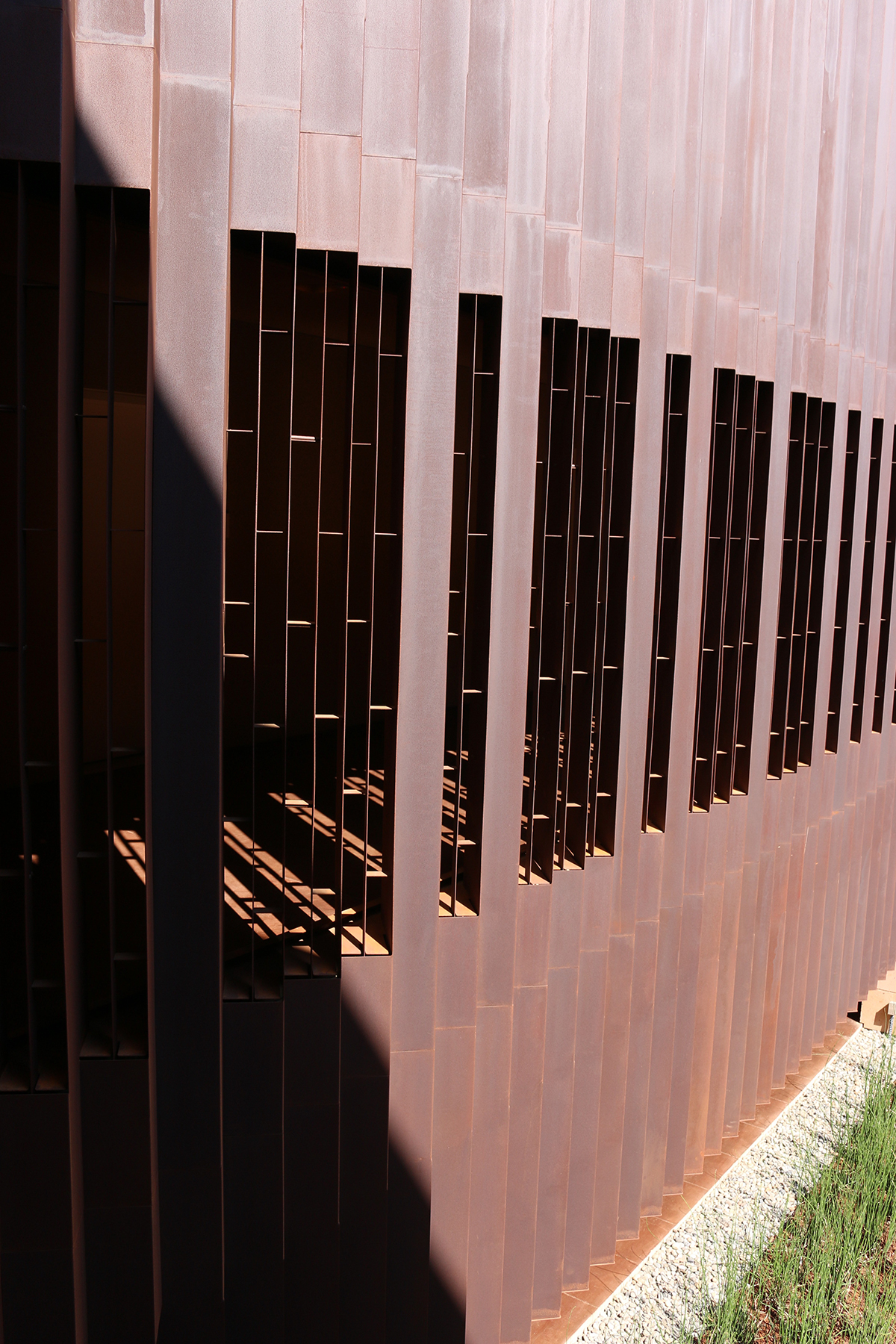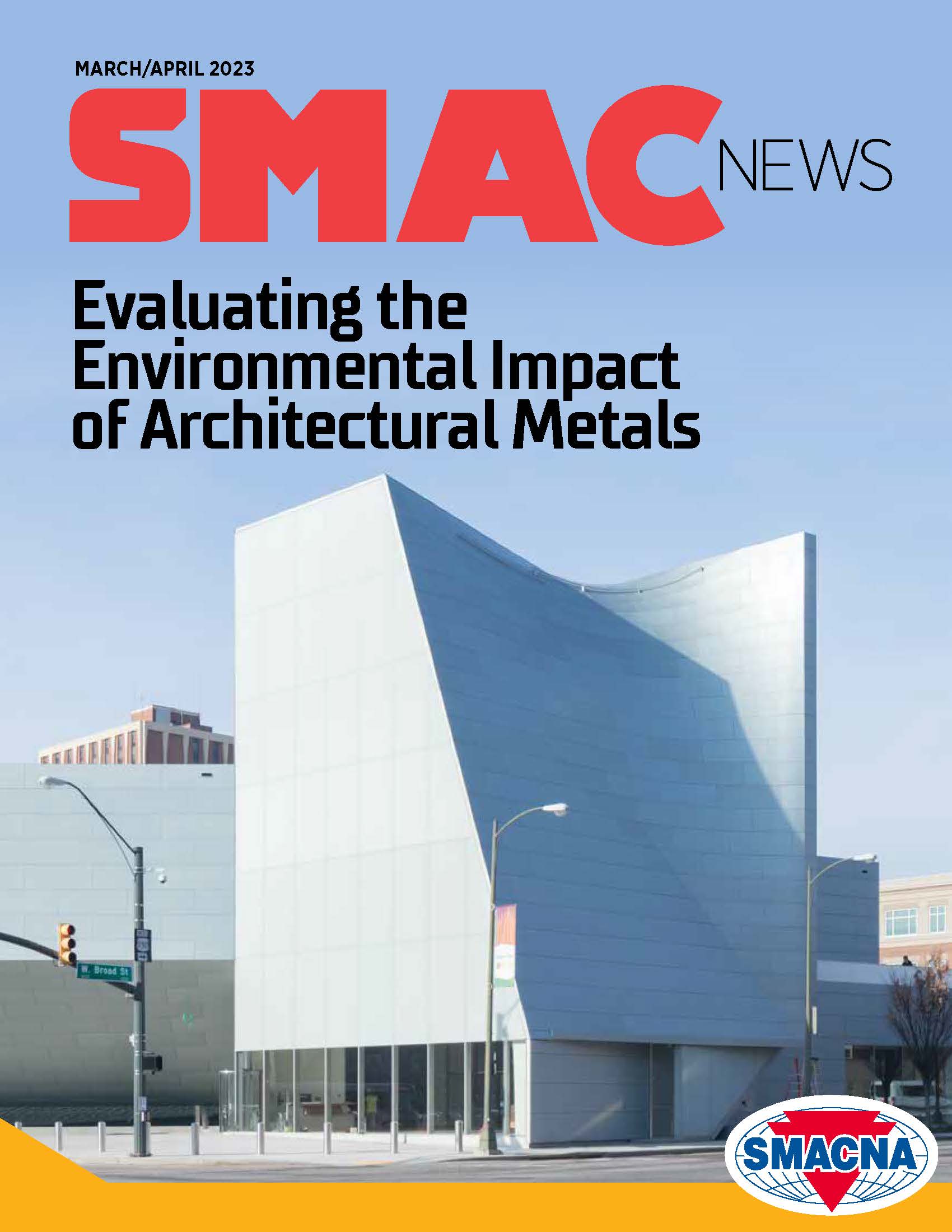Evaluating the Environmental Impact of Architectural Metals
Zahner talks about how the Life Cycle Assessment accounts for the environmental impact of metal material from its initial extraction through manufacture and use and on to the end of its designed useful life.
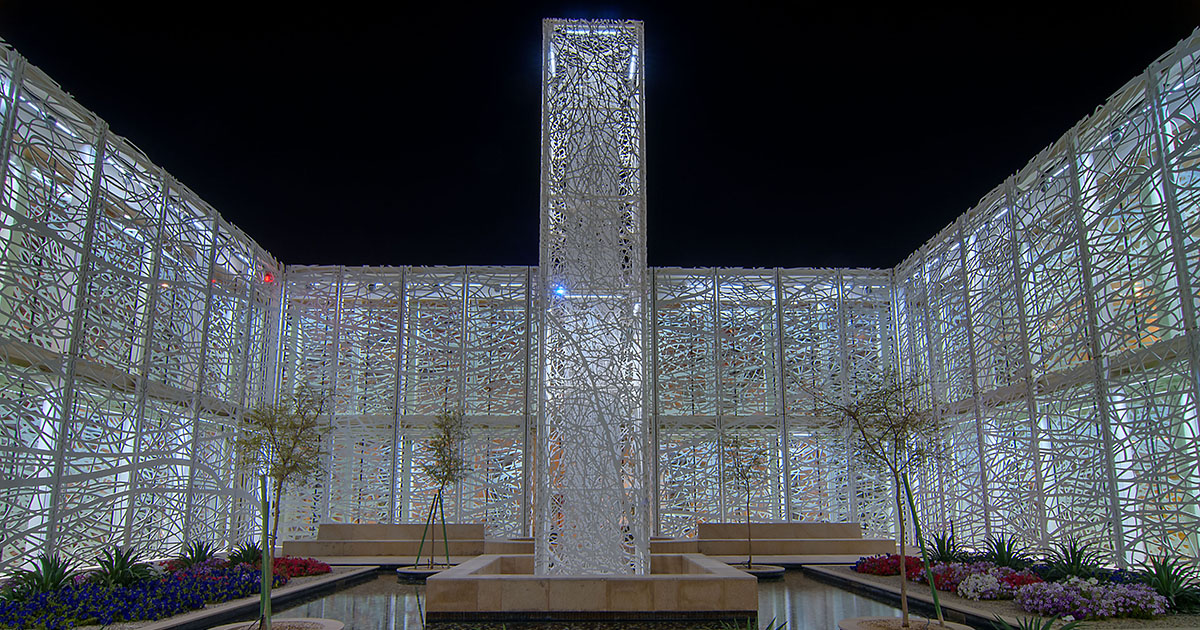
For this art wall at HBKU Doha University's student center, Zahner engineered and manufactured the painted aluminum panels and substructure in Kansas City and shipped the completed pieces to Doha, Qatar, where local installers placed the large metal plates on both the interior and exterior frameworks.
On the cover of SMACNews is the Virginia Commonwealth University. Zahner worked with Steven Holl Architects to develop the design.
Sustainability discussions are increasingly relevant in the construction industry, as greater attention is being placed on how the embodied carbon (or carbon footprint) of buildings and their materials can be measured and reduced through recycling opportunities.
The Life Cycle Assessment (LCA) standard is one method of examining the environmental effects of a material or product over its life cycle. It supports better material selection and design decisions.
Metals specific to Zahner projects, such as aluminum, copper, zinc, and iron (stainless steel and weathering steel), are examined as an aggregate group rather than an individual metal and as a material rather than a product.
Sometimes referred to as “cradle-to-grave” analysis, the Life Cycle Assessment examines material from its initial extraction, through manufacture and use, and on to the end of its designed useful life. For metals, useful life generally means when the building or structure is no longer functional.
From Mineral Ore to Recycled Material
While there are nuances in each metal, the path they take through the various life cycle stages are similar. All metals originate as mineral ores extracted from the earth and retain an intrinsic value regardless of form as long as they are not laminated to plastics or foams.
All manufacturing facilities that work with metals have a robust recycling operation that captures off fall and shavings from the processing of the metal. This scrap developed during manufacturing has a value that adds to the bottom line.
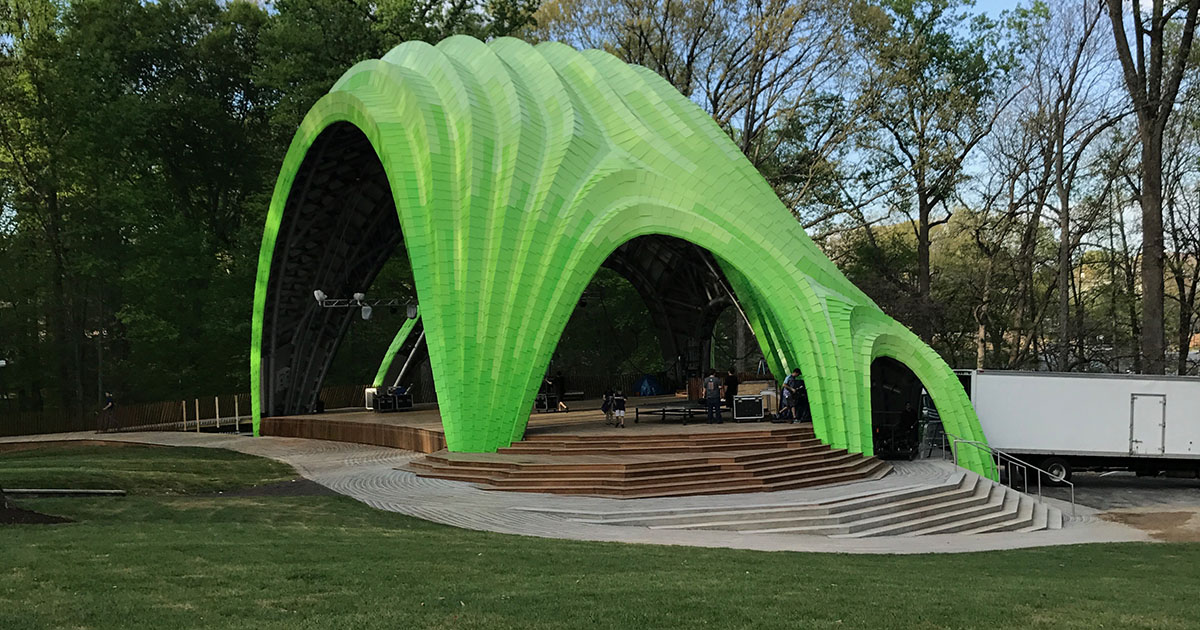
The Chrysalis Amphitheater at Symphony Woods Park in Columbia, Maryland, is made of tubular steel knit together to form a structure that houses a pavilion and stage for performances.
Lastly, metals are relatively heavy compared to other building products. Still their resilience allows for reduced packaging (and the ability to maximize truck or container loads).
Metal’s Unrivaled Useful Life
Metal has a longer useful life than other materials. Metal surfaces and structures offer a resilience that withstands the confrontations posed by the weather and human interface.
Metal roofs outlast all other roofing materials. Metal walls will outlast all other materials when correctly designed. And while surface coatings such as paints may fade or chalk over, the metal will last.
Consider the DeYoung Museum of Art in San Francisco, California. An earthquake damaged it when it was made of stone.
For all its strength and durability, stone lacks resilience and cannot be recycled. Some of the stone was repurposed after the original museum’s demolition, but much went to the landfill.
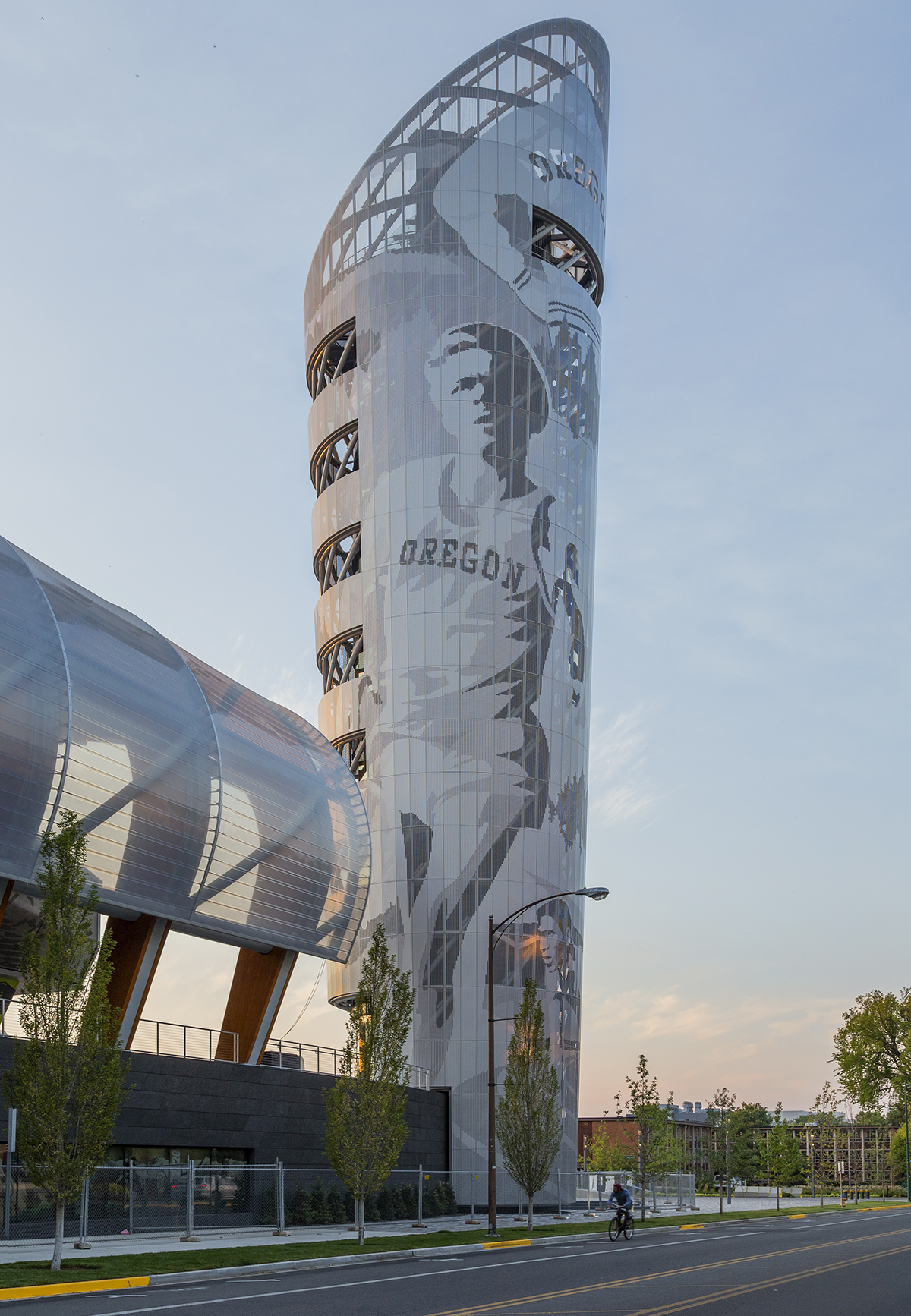
The renovations Hayward Field at the University of Oregon from 2018–2020 included the addition of a 9-story tower at the northeast corner of the stadium. This landmark was inspired by the Olympic torch and pays tribute to the university’s legacy depicting five Oregon track and field icons. Zahner engineered and fabricated 15,815 square feet of aluminum ImageWall panels for this design.
The new DeYoung Museum is clad in copper. Mismanufactured, damaged or scrap sections of the copper were recycled, as well as all the perforations. And because copper is more resilient, it will not crack during earthquakes.
Several hundred years from now, when the building’s life is over, the copper will be recycled into new copper.
Five Stages of Life
The Life Cycle Assessment considers five distinct stages in the life of a product. Each stage of the assessment compiles the inputs required from the environment. These inputs include energy, water, packaging materials such as wood, and temporary protective coatings.
Additionally, each stage records any detrimental outputs into the environment. These outputs include landfill waste, air quality effects from dust or VOCs released, and water quality effects such as silt, pH-altering chemistry and contamination.
Stage 1: Raw Material Extraction
INPUTS
• Energy
• Water
OUTPUTS
• Dust particles
• Contaminated water
• Mine tailings
Metal ores make up the majority of substances extracted from the earth. Several tons of overburden and rock are excavated for every ton of ore extracted.
Regulations on mining operations vary between countries. Unfortunately, most mining operations have moved offshore to developing countries (where regulations are loose).
High operating standards are in place in North America, driven by environmental and labor laws. The Surface Mining and Reclamation Act (SMARA) requires the reclamation of the mined land.

The new DeYoung Museum of Art in San Francisco, California, is clad in copper. Some of the copper came from mismanufactured, damaged or scrap sections of copper that were recycled and reused.
The Mines of Spain recreational area outside of Dubuque, Iowa, is an example of reclaimed land. Large lead mining operations occurred here in the 19th and early 20th centuries.
In the 1970s, the community and the Department of Natural Resources purchased the property and created a park and wildlife habitat that flourishes today.
The extraction of metal from ore requires an extensive amount of energy. Extraction equipment consists of large earth-moving machines, and transportation from the site requires dozens of massive trucks.
The extraction process requires an input of water in the floatation and separation of the ore. Once contaminated with various substances, this water is held in containment ponds and can be considered an output.
Air quality from the dust released in the excavation process and emissions from smelting operations are additional undesirable outputs from the extraction process. However, most mining operations are remote, so the risks of dust are concentrated near the mine.
The Enigma of Metal Extraction
The extraction of ore to generate new metal is, without question, the most detrimental stage to the environment in the Life Cycle Assessment. This introduces a conundrum, as the produced metal has the potential to exist in useful forms indefinitely after this extraction.
Energy used to transform a mineral substance into a refined metal remains ‘locked’ into the material. Corrosion of metals occurs slowly, and for most metals used in architecture, this corrosion adds a protective layer that resists further change.
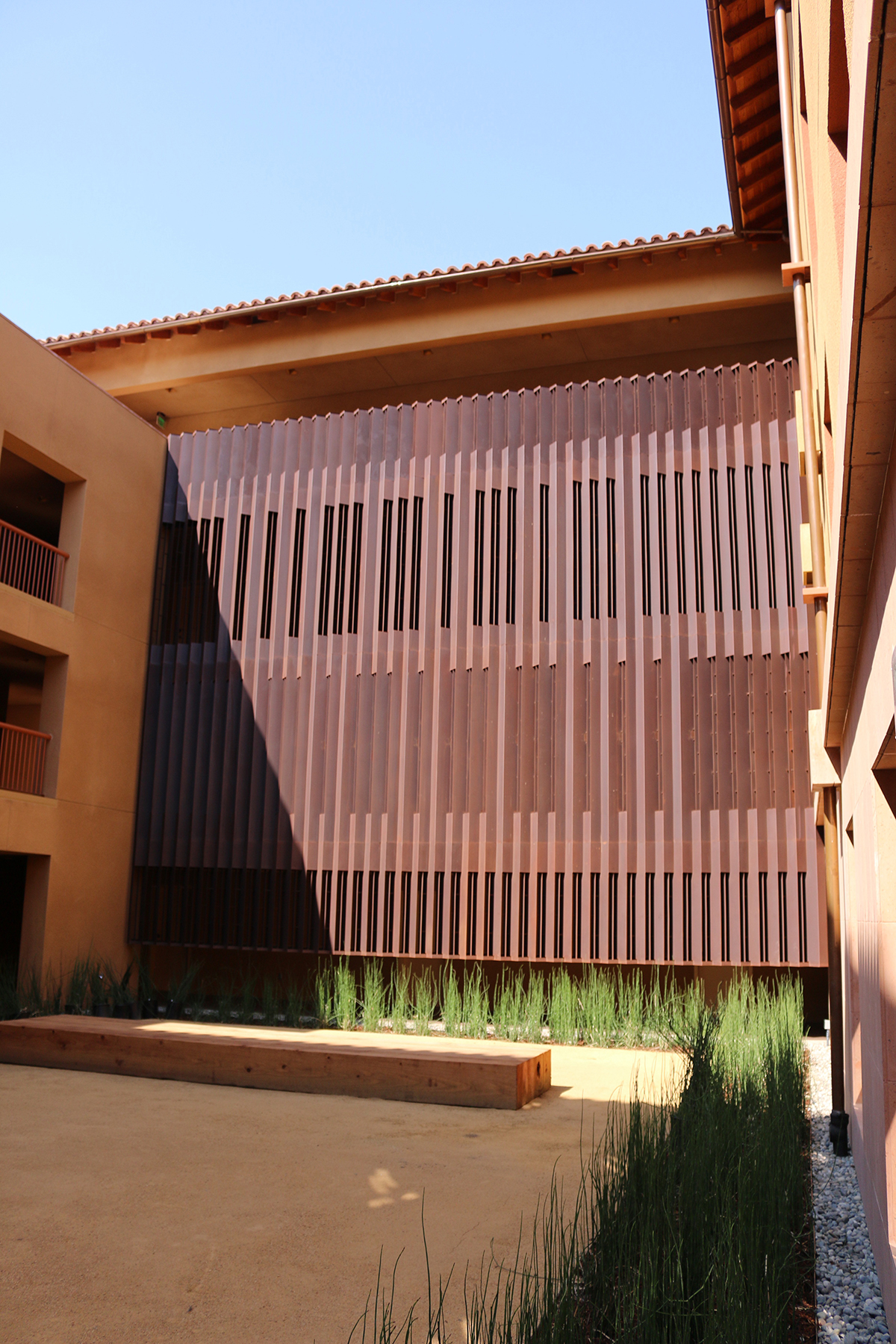
Weathering steel, with its copper-bearing properties, forms its own distinctive oxide barrier over the surface like that seen below and far right at Stanford University.
What’s more, recycling metals has become an industry unto itself. It keeps metals out of landfills and is of such importance that scrap values are established as a market (metal scrap is a traded commodity).
Recycling metals can replace mining and the detrimental characteristics that mining possesses. And it can restore physical and mechanical properties to the point where there is no distinction between recycled and virgin metal.
The energy needed to recycle and restore metal is considerably less than energy used in the extraction process. There is no damage to the land, and you can find recycling centers in every sizable city around the globe. No other material used in construction can make this claim.
Stage 2: Manufacturing
INPUTS
• Energy
OUTPUTS
• Temporary packaging material
There are two distinct phases of the manufacturing stage. During phase one, the large metal mill takes the refined metal and scrap, adjusts the alloy needed, and turns it into base shapes and wrought forms.
The second phase of the manufacturing stage takes place at the smaller shop or plant that receives the metal forms. Here, the metal is worked into panels, handrails, column covers and other items used in construction.
During phase one, an input of heat energy and mechanical energy is required at the mill to create the base metal forms.
Scrap metal is processed using induction furnaces. These systems distribute the heat energy with high efficiency using electricity. Induction furnaces reduce waste energy, do not produce any gasses and can generate electrical energy through renewable sources.
Once melted, the metal scrap or ingots are transformed into large slabs or cylinders before they are shaped under mechanical pressure into plates, sheet metal coils, wire, extrusions and other structural forms.
These base metal forms may now continue to the next destination, where transporting, stocking and distribution are maximized on flatbed vehicles or containers on a rail.
After arriving at phase two of the manufacturing process, the energy requirements drop significantly. The required inputs are mainly limited to forklifts and large shaping machinery.
For the average-size factory, the energy required to shear, laser cut, weld, press form, stamp, forge or extrude is equivalent to the energy needed to operate several homes at best.
Material outputs include wood for the skids and crating, plastic films for protecting the surface, steel banding and cardboard.
Water is required for some of the finishing operations. But at Zahner, the water is purified and recycled through reverse ionization, so it is not considered a negative output.
Of all the outputs, plastic film is the most problematic. It protects the finished surface, but becomes landfill material for a very long time.
Stage 3: Transportation and Distribution
INPUTS
• Energy
OUTPUTS
•Packaging materials
Transportation from the mill to distribution centers is similar to other products in the industry.
Zahner pre-assembles our metal components into large sections to reduce crate and packaging waste. Our materials are lightweight and require less fuel to deliver.
At this stage, metals are not that much different than other materials. Transportation may even be less costly due to the weight and durability of metal products.
Stage 4: Construction and Use
INPUTS
• Energy – Low
OUTPUTS
• Packaging material to the landfill
The fourth stage in the life cycle of metals is where they truly excel. Metals resist change, have better resilience and come in a variety of forms.
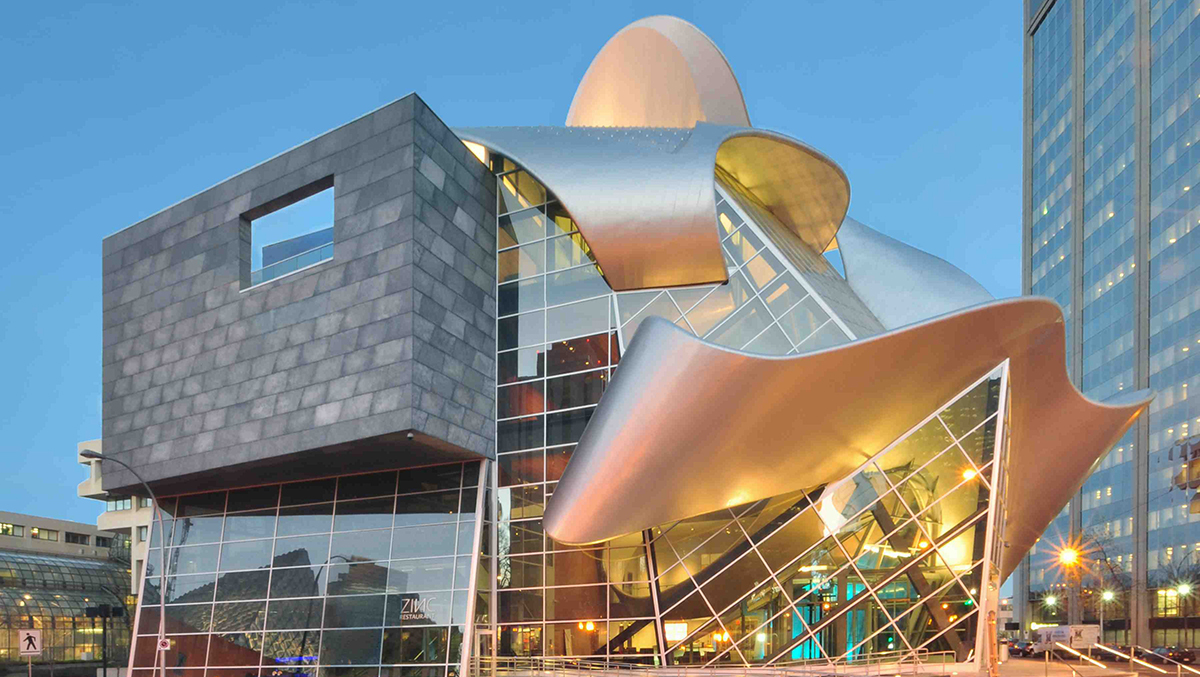
The Art Gallery of Alberta (AGA) is a Canadian museum in downtown Edmonton that features a Zahner-manufactured curvilinear canopy and building envelope system.
Cold weather, wind, sunlight, rain, pollution and other external conditions have little effect on metal surfaces when produced and installed correctly.
According to the Aluminum Association, 75 percent of the aluminum produced in the United States is still in use today. Copper roofs installed on structures in Europe have performed well for centuries. In fact, metals often outlast the structures they clad, with few maintenance requirements necessary.
High-performance paint finishes applied to metal can be thermal set without altering the metal. Or they can be left natural and unpainted to capture substances deemed pollutants in our air and turn them into protective layers.
Exposed copper develops its green-blue color after it captures sulfur from the air. This mineral layer adds natural beauty and an inert surface that resists change, similar to zinc, which weathers over time by combining with atmospheric carbon and turning a dark gray in color.
The energy requirements to build with metal products are minimal compared to other options.
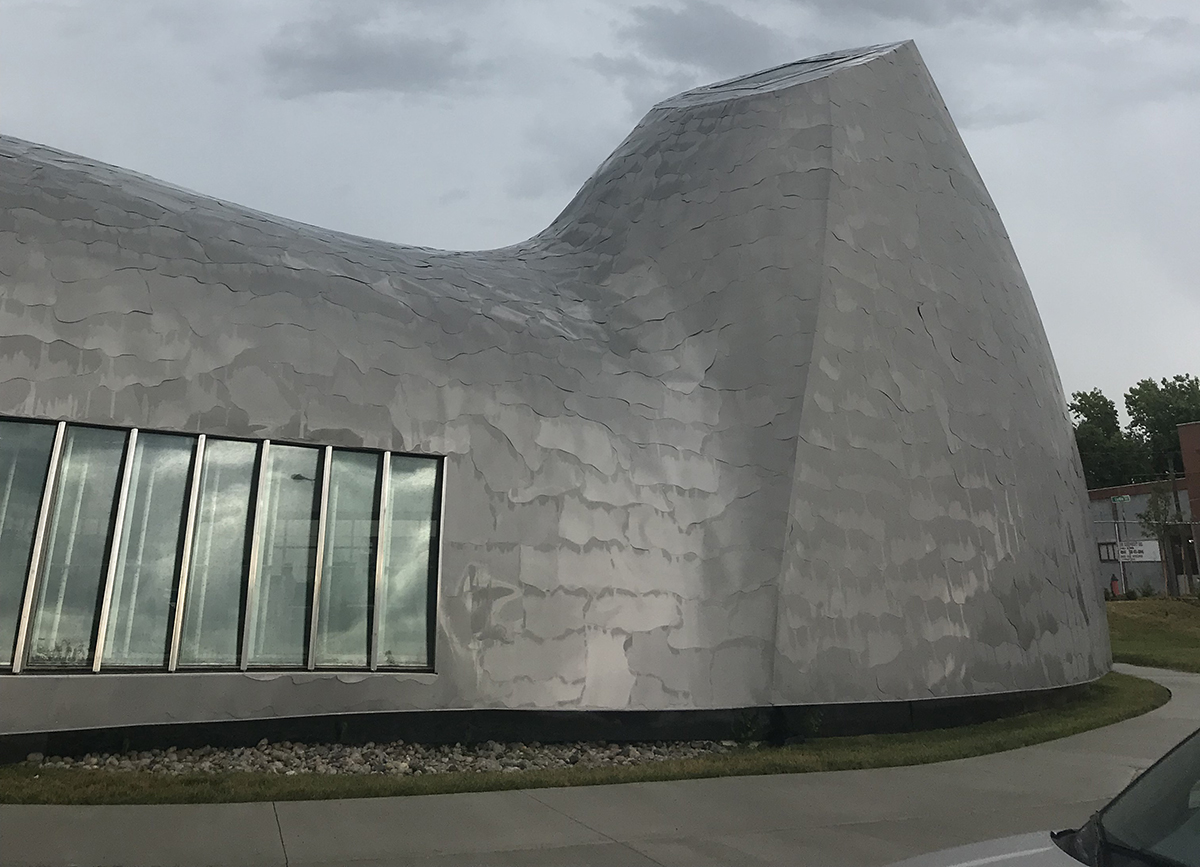
Zahner’s headquarters was too small for their growing staff, so they added a new 17,000-square-foot space designed to encourage interaction inside while piquing the interest of those outside.
Metals are stronger yet lighter than most materials. They can offer a more economical structure (greater spans with minimized support attachments). No water nor sacrificial material other than packaging is involved.
Final Stage: Re-Use, Recycle, Disposal
INPUTS
• Energy
OUTPUTS
• New metal for reuse
This last stage in the life cycle assessment is where metals have no equal. Metals — and only metals — can be used indefinitely as building materials.
Metal recycling is a burgeoning business. When metals are recycled, the original mechanical properties are restored. Energy is needed in the recycling process but at levels far less than at the extraction stage.
The United States has become a major secondary producer, meaning new products are often created from recycled metal scrap than virgin metal ore.
When evaluating metals in this stage, it should be assessed with a reduction of the extraction stage because it replaces the need for extraction.
Recycled metal has all the properties of metal made from raw material extraction but at a much lower energy input. Little to no water is required.
On the output side, there is little waste, dust or damage to our water systems to produce recycled metals. Except for removing paints from metals, the air quality is not affected.
Final Summary: Life Cycle Assessment Comparative Scorecard
One can see that on a scorecard summary, recycled metal has the lowest (best) score. (See scorecard below). While metal extracted from ore is rivaled only by wood.
The significant advantages of metal in the construction and use phase, combined with the benefits of recycling, offset the initial environmental disadvantages of extraction.
One can conclude that architectural metals offer a sustainable edge when it comes to designing and building with the environment in mind.
This article was written by L. William Zahner. Zahner has produced an Architectural Metal Series, published by John Wiley and Sons. Check it out at www.azahner.com/resources/publications.
Metal is a Low Waste, Sustainable Building Material
Exploring Metal’s Role in Sustainable Architecture
Published: May 16, 2023
IN THIS ISSUE
Big Clients Require Big Partners
JPMorgan Chase & Co.’s global headquarters becomes AABCO’s next commercial HVAC client in NYC.
Bringing Shade to Schools
Intech helps install sheet metal shade structures at California schools.
Evaluating the Environmental Impact of Architectural Metals
Zahner talks about how the Life Cycle Assessment accounts for the environmental impact of metal material from its initial extraction through manufacture and use and on to the end of its designed useful life.
Exploring metal’s role in sustainable architecture
Metals are different from nearly all other materials used in our built environment. Once the useful life has ended, the metal is collected and recycled.
Going to Market
With advertising, 128-year-old Welsch Heating & Cooling Co. isn’t afraid to try new ways to reach their customers — as long as they work.
How to Prepare Your Business for Cyberattacks
Bulletproofing your business against a cyberattack can help protect you from today’s threats.
Metal is a Low Waste, Sustainable Building Material
Sustainability is more than just an industry buzzword at Zahner. It's a daily commitment to preserving and protecting the natural resources we’ve been entrusted with and using them responsibly in the built environment.
Sheet Metal Werks Shifts Field Hours to Shop Hours
The Illinois company saved significant man-hours by planning ahead.
SMACNA at the White House & SMACNA Endorses Bipartisan Bill on Substance Abuse
SMACNA was asked to be part of a policy roundtable on supply chain for highly efficient heat pumps and related decarbonization technologies that are key parts of whole house retrofits.
SMACNA Government & Technical Updates & Engagement Opportunities
The first quarter is always busy at SMACNA. We have lots of association events, our technical department is out in force, labor is starting its bargaining season and the government relations team is focused on many regulatory issues.
The Challenges With Manning Megaprojects
With the pandemic entering a new phase, construction has boomed with what are now widely known as “megaprojects.” Every day, it feels like there’s a new stadium, microprocessor factory or some other massive project getting underway. The demand for
Top Contractor Strategies for 2023, Part 2
In the last issue of SMACNews, I presented the first five of Grassi’s Top 10 Contractor Strategies for 2023. Those approaches to purchasing, procurement, prequalification, increased costs and project management are designed to cut through the noise
Understanding The Notice Requirements In Your CBA
For contractors with collective bargaining agreements (CBAs) expiring in 2023, it is important to remember that most CBAs, including the Standard Form, include an “evergreen” or “automatic renewal” clause.


